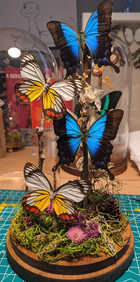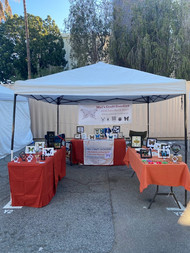Mel: Entomological Artist
- Lonely Artist Club

- Jan 21, 2023
- 7 min read
Lonely Artist Club had the pleasure of sitting down with entomological artist Mel to discuss her craft and unique creative passions. Let's just say we kind of *bugged* out over her work. Let’s jump in…

Thanks for meeting with us Mel. First and foremost, we want to talk about your art. What medium do you work with and how did you come to find it?
I work with insects, bats, scorpions and various kinds of spiders. I started with mounting butterflies and displaying them in frames and jars. My mom had found a butterfly that was dying in her garden and she brought it inside to give it some water. The next morning it had died. We couldn’t bring ourselves to throw the butterfly away, so I quickly learned how to spread and mount butterflies via YouTube. I thought the process was very therapeutic and beautiful; to bring an organic specimen to such a beautiful state after it had died.
"I quickly learned how to spread and mount butterflies... I thought the process was very therapeutic and beautiful; to bring an organic specimen to such a beautiful state after it had died."

We want to hear more about your art, but first can you tell us a bit about who you are outside of your creative work?
I Work a 9 to 5 that I really enjoy. Outside of my full time job and bug business, I try to spend time with friends and family, paint, play video games, and be outdoors camping or road-tripping. This year I’ve shifted my focus to traveling and putting myself out there to see what new endeavors I can accomplish and what I can learn.
"I’ve shifted my focus to traveling and putting myself out there to see what new endeavors I can accomplish and what I can learn."

Almost every artist, at one point or another, experiences a creative block, right? Would you mind sharing your personal experience with managing and overcoming creative blocks or ruts?
Yes, when I find myself in a creative block, my art feels like a chore that I need to get done, or a task I need to fulfill. Basically any sense of ‘drag’ or laziness towards creating tells me that I’m going to be mentally blocked.
If I’m feeling this way, I purposely set myself up. I sign myself up for a market or reach out to people who have seemed slightly interested in a commission. If I owe someone a piece, and they’re paying for it, I better get it done. If I’m selling at a market, I need to have pieces to sell.
Overall, I think understanding the mechanisms of what makes you tick as an individual is very important. You need to understand yourself and what works for you. Forcing art doesn’t always work, either. If you feel stuck, you should try to find a balance between seeking inspiration and giving yourself a break.
"...Understanding the mechanisms of what makes you tick as an individual is very important. You need to understand yourself and what works for you. Forcing art doesn’t always work... If you feel stuck, you should try to find a balance between seeking inspiration and giving yourself a break. "

Creative blocks are challenging to overcome, but it sounds like you have a healthy approach to overcoming them. With that being said, is there another aspect of your work as an entomological artist that is equally, if not more, difficult to manage?
The hardest part for me is starting the project. It’s easy to imagine the direction you’re going in or idealizing the final look, but once you’ve worked on similar projects before, you know the realistic side of the process, and it can be intimidating and exhausting. Even building up the energy and courage to kick-start the project can be such a drag sometimes.
I don’t think there should be a consistent ‘hardest part’ of any piece or project. I think it should vary depending on the project you’re working on - who knows what challenge will arise. It seems much more organic and authentic for the hardest part to arise and find itself within each project. Sometimes I struggle with starting, sometimes it’s with letting the end-result be the end-result, and sometimes it can just be sourcing materials.
"I don’t think there should be a consistent ‘hardest part’ of any piece or project. I think it should vary depending on the project you’re working on - who knows what challenge will arise. It seems much more organic and authentic for the hardest part to arise and find itself within each project."

This next question is a bit more candid, but we gotta ask! Do you have any fears surrounding your art?
I don't have any fears with my pieces specifically, but if I had to narrow it down to something it would be the fragility of my pieces. I work with glass, paper-thin specimens, organic flowers and moss. I always run the risk of damaging my pieces as I’m putting them together - and I often do. Luckily, I’ve learned how to repair specimens to look as if nothing’s happened.
On a deeper level, I’ve been denying the fear of growth for a while. I know I can grow my business utilizing social media, but my brain refuses to let me do it and I still haven’t figured out why or what it is I’m scared of. Just the thought of marketing myself makes me cringe and avoid it at all costs.
"I work with glass, paper-thin specimens, organic flowers and moss. I always run the risk of damaging my pieces as I’m putting them together - and I often do. Luckily, I've learned how to repair specimens to look as though nothing has happened."

Speaking of social media... what are your thoughts on it and how it effects on artists?
I think social media is great for artists. It’s a terrific way to showcase your talents and show the world what you can do and who you are. With that being said, I haven’t been around long enough or made art my primary focus. I feel as though I haven't assessed social media and its effects to the full scope - I’m not sure if any one person can.
"I feel as though I haven't assessed social media and its effects to the full scope - I’m not sure if any one person can."

That is so very true. Social media seems to be changing indefinitely. Who can say if its for better or worse and what effects it has or will have on us artists in the future... Now, if people were interested in your artistic medium whose work would you recommend they look at/ research and why?
I try to not follow too many entomology art pages because I want to be as authentic in my pieces as I can be. However, I find a lot of inspiration to come from artists such as @Papillart.Paris_.18e on Instagram. Researching bugs from an entomologist-view is best, as it teaches you a lot about their origins and characteristics, and you can find yourself… even months later… creating pieces inspired by their natural habitat! You’ll never come across useless information if it’s within your line of work.
"You’ll never come across useless information if it’s within your line of work."

Have you ever created something by accident that you ended up loving? (Image shown below)
When I first started, I made a frame for a tiger butterfly. It wasn’t until I glued it to the frame that I realized the frame was far too large for the butterfly. I ended up playing with the design, adding other butterflies to the frame as well. I also threw in some flowers and ended up with a larger piece of colorful surprises! This frame single-handedly created a new line of designs for me that I wouldn’t have known existed if it wasn’t for mis-pairing a butterfly with a frame too large for it… and guess what - it’s currently on someone’s wall in NYC!

Your pieces are truly stunning. Where do you seek inspiration from?
I try to focus on colors and pull inspiration from the specimens themselves. I let them drive the design and look of the final piece from their colors, shapes, and textures. If I have flowers matching the butterfly’s look I will use those or I will use a background that will make the specimen really pop.
"I try to focus on colors and pull inspiration from the specimens themselves. I let them drive the design and look of the final piece from their colors, shapes, and textures."

We just have one last question for you (wahhhh!) What advice would you give to other artists out there?
Let the specimens inspire you. Utilize their natural beauty and emphasize it in your displays. Butterflies mean a lot of different things to many people; what do they mean to you? Showcase it in your pieces and you will find authenticity in your work.
Another important piece of advice is to never turn down custom work if you believe you can achieve the results your client seeks. A lot of times I gain new and fresh ideas from clients who have an image of what they want. Cooperative work is by far my favorite method of approaching art, so please take on that custom. You will come out of it with a new skill or vision, whatever it may be - and maybe a new friend as well.
"Cooperative work is by far my favorite method of approaching art, so please take on that custom. You will come out of it with a new skill or vision, whatever it may be - and maybe a new friend as well."
Thanks again Mel for sharing your work, background, and creative process. It was truly a pleasure chatting with you.
If you want to learn more about Mel, check out her socials:
Instagram:@MelsCraftGoodies
Website: www.melscraftgoodies.com
Upcoming projects: Melrose Trading Post (Los Angeles) most Sundays from 9am - 5pm. Keep an eye on my social media for updates



































Comments